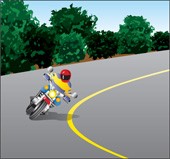Curve
This driving task begins when the curve comes into sight and ends when you have gone completely around it. Follow these actions:
Speed
As you approach, try to determine the safe speed for the curve. To do this, look for clues such as a sign that shows the safe speed, the shape of the curve and the type of road you are driving on. Enter the curve at a safe speed. In a blind curve where you cannot see all the way around it, drive more slowly in case oncoming traffic wanders into your lane, or the curve is tighter than you expected. If your motorcycle has gears and you need to downshift, do so before entering the curve; do not shift gears in the curve. Not changing gears gives you more control over your motorcycle and reduces the risk of your wheels locking while downshifting. While in the curve, drive at a speed that balances the forces created by turning on the curve. Near the end of the curve, begin accelerating to return to normal speed.
Lane
As you enter the curve, look as far around it as possible. This helps you stay in a smooth line around the curve. If you look only at the road directly in front of you, you are likely to wander back and forth across the lane, constantly correcting your steering. On a curve with a short sight distance, drive in the tire track where you can see more of the road ahead. If the curve is to the left, use the right tire track. If the curve is to the right, keep as far left as possible while watching for oncoming traffic that might be cutting the curve short. You may also change tire tracks in order to drive through a more gradual curve than if you followed the full curve of the road.
